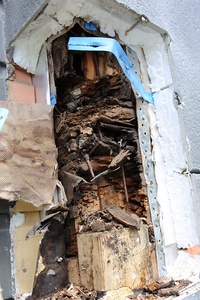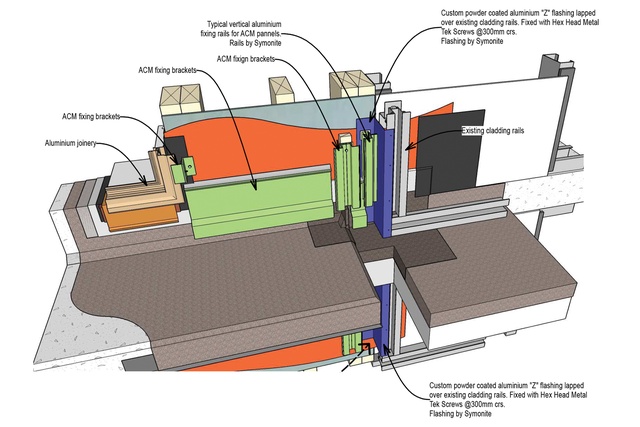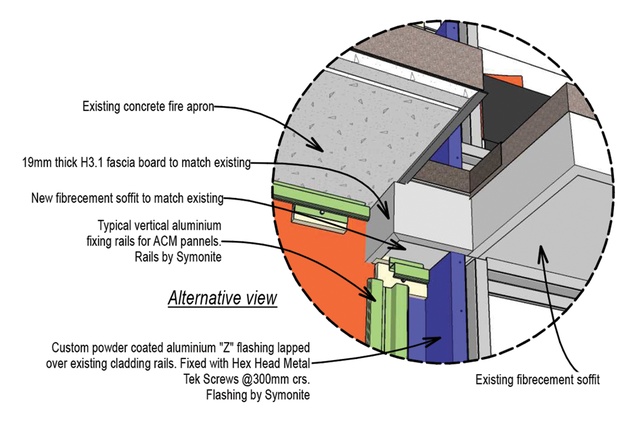Something rotten in the state…
Peter Dyer delves into the thorny issue of whether or not targeted repair might be a better solution to New Zealand’s ongoing leaky buildings saga.

In late 1994, an ugly new problem surfaced in New Zealand buildings – far too many were found to be quickly rotting. Within a few years, the problem mushroomed into a massive, full-fledged disaster generating an entirely new industry known as weathertightness remediation.
As the new industry evolved, a new perspective – extreme risk aversion – appeared. Not only were many thousands of buildings rotting but the fix was becoming ruinously expensive. Risk aversion enabled the capture of the industry by what can be summarised as the full re-clad/re-roof solution. Only a small minority advocated for effective and less-expensive, targeted repairs. To the majority, as building surveyor Mark Hazlehurst put it, targeted repairs were “… about as welcome as a fart in a spacesuit”.1
More than a quarter of a century later, we are still building leaky buildings.2 Total re-clad/re-roof remains the default repair method. And, while many weathertight failures clearly demand full re-cladding, some are questioning whether or not this one-size-fits-all solution is sensible. Is it even possible?
The 2009 PricewaterhouseCoopers (PwC) report Weathertightness – Estimating the Cost estimated the average cost for a full re-clad of a residence at $300,000.3 In 2015, Data on Residential Weathertightness Failures estimated that more than 174,000 New Zealand dwellings built between 1990 and 2014 would be “very likely to leak”.
The Ministry of Business, Innovation and Employment (MBIE) has never published this report.4 This may have something to do with the maths: applying the PwC 2009 figures (not adjusted for inflation) to the 2015 data tells us that re-cladding all these homes will cost $52.3 billion. This estimate is about homes only. Both reports ignored all other buildings: schools, hospitals, prisons, commercial buildings, etc. Clearly, it won’t be possible to re-clad fully every leaky building.
However, there is hope. A resolution to this vexing situation has been hiding in plain sight: the Building Act 2004.
In 2012, concerns over thousands of leaky schools drove the Ministry of Education to establish its Building Improvement Programme. It engaged a number of larger building surveying companies to investigate 2450 “identified buildings”. The estimated cost of repair was between $1.3 billion and $1.5 billion (average $530,000–$612,000 per building).5, 6
More than five years later, fewer than half had been fixed. By January 2018, approximately 1300 buildings remained to be assessed or remediated.7, 8
Looking for solutions, the Ministry realised that, in most of these buildings, there was “specific and localised weathertightness failure, but the building work carried out was often based on a full ‘re-roof’ and/or ‘re-clad’ approach”.9
The Ministry decided to revise its focus of remedial work to address actual and proven weathertightness failures. Factors that might lead to “future weathertightness failure of building elements” would not be addressed unless they were “considered likely to cause imminent failure”.10

This game-changing decision was laid out in the 2018 report Weathertightness Remediation and Regulatory Strategy. Authored by the Ministry’s Weathertightness Strategy Group (WSG),11 this meticulously reasoned work has a solid foundation: the performance-based spirit and intent of the Building Act 2004.12
Before this decision, Ministry remediation work had been largely prescriptive, dominated by the mainstream focus on Acceptable Solution E2/AS1. However, according to the WSG, this had “led to incorrect expectations of what is required for compliance with the Building Code”. Moreover, it had “resulted in significant additional cost in carrying out remedial work…” 13 In sum: if the work was performed as required by B2 Durability and E2 External Moisture, it complied with the Building Code. It followed that, “The building can comply with the Building Code without being built in accordance with E2/AS1”.14
The Ministry noted that the Code does not require a wall or roof building element to be ‘re-clad’ or ‘re-roofed’ rather than repaired to address any weathertightness failure or consequential damage. For the majority of remedial work, “the building element can remain in situ and the necessary repairs carried out”.
In the absence of “any evidence linking an as-built feature or detail to a weathertightness failure and consequential damage”, even direct-faced cladding can be repaired, rather than replaced with a cavity system.15
Outside the Ministry of Education, however, resistance to targeted repairs continues, solidly grounded in risk aversion, largely driven by the issue of insurance.
Industry perspectives
Mark McLeay, architectural designer and managing director of Resolution Architecture, says his company’s professional indemnity insurance does not cover his firm for targeted repairs. “It’s difficult from a professional perspective to opt out of the areas not being targeted, especially where there is a junction between the areas being remediated and the area not.”
Resolution’s policy, McLeay says, is generally to rely on the building surveyor for information and perspective, coupled with Resolution’s years of assessment experience. Importantly, maintenance is built into the remediation contract.
Given developers require contractors to post bonds, could councils perhaps require developers to post bonds? McLeay says this would amount to a great deal of insurance for one building. “If the bond were for 10 years, this would have to be factored into the development and the cost would need to be passed on.”16


On the other hand, Paul Grimshaw, founding partner in leading dispute resolution law firm Grimshaw & Co, has advocated exactly this. However, he says this would require a large shift in the New Zealand legal liability structure, which, at this point, seems “too hard”.
Grimshaw proposes a more radical step: that each company earns its limited liability status after, say, two years. A developer would post a bond, underwritten by insurance. A responsible company would have a long life. “Unfortunately,” he says, “there is not one developer in New Zealand like that.” He believes New Zealand needs radical reform of the limited liability regime.17
Architect Malcolm Walker is clear: “Everything leaks, so it’s a matter of designing for this. A lot of these companies get an hysteria going about the remediation process. Then they book themselves into a lot of redundant work that shouldn’t have to be done.”
So, is there scope for targeted repairs? “Yes,” says Walker. “They should always be targeted. Always.”
Walker cites a “quite expensive” studio house, not his, where just window flashings on four windows were leaking. “The rest of the house was perfectly alright. It was performing perfectly well. And they re-clad the whole thing.”
In Walker’s opinion, this indicates an unhealthy remediation industry. “People do mad things to perfectly well-built houses. That’s not always the case, of course, but remedial work does offer an opening to chancers and opportunists and the industry needs to be vigilant.”18
Structural engineer John Adam has never been too interested in targeted repair. Adam’s approach is pragmatic: “You just have to go over the whole thing”. In addition, risk-averse councils make chances slim for approval of targeted repairs. Targeted repairs can ensure weathertightness, he says, but there is a danger of missing other structural issues. His experience has persuaded him that everyone – even master builders – needs proper supervision. “Who’s keeping an eye on them?”
Adam spoke of building booms and cowboys. Windows would be ordered and delivered but all of the old familiar flashings were gone. This caused confusion. For example, on one site, a head flashing had been installed upside down.
Councils are bearing the brunt of all this, as a council is the last man standing. This causes risk aversion and escalation of costs. “I hope we’ve learned something from the whole sad occurrence,” he says. “However, don’t rely on the people who caused the problem to fix it.”
Building inspector James Hammond recalls that, in the early days of remediation, sensibility and balance prevailed. “But the industry has changed a lot,” he says. “Eventually, this gave way to blanket full re-clads. Though the vendor is hurt, it’s a gravy train for parties on the other side.”
Over the years, many inspectors came to condemn anything with monolithic cladding. Hammond knows of at least one house that was re-clad simply because the cladding was direct-fixed.
Risk aversion or, as Hammond put it, “covering rear ends” drives all of it: “You can get in trouble just by setting foot on the property”. As a result, repairs are often done below the radar. Some of these houses become time bombs, resulting in “a lot of hurt, a lot of heartache”.
Damage is not limited to claddings and timber. The stress of $300,000 re-clads has destroyed relationships. He made reference to the 3 Ds: “Dampness, Divorce and Despair”.
Mark Thomas, of Specialist Coating Services, has a warning: “Beware. When someone walks up the driveway to do a building report, you’re about to play a game of Lotto.”
Thomas says you may be at the mercy of a member of a group of “self-appointed experts” and he points out that the skill levels underlying pre-purchase reports are “a rabbit hole”.
This is because anyone can do a pre-purchase inspection and report. There is no formal qualification. New Zealand Standard NZS 4306 outlines ‘competencies’ for inspectors. However, like all New Zealand Standards, NZS 4306 is only a guide until it is referenced by, or incorporated into, legislation.
This has not yet happened.19 So, it’s up to vulnerable owners of leaky homes to make well-informed, reasonable decisions.
Building reports, Thomas says, are typically worded to avoid liability. The focus is more on risk aversion and less on common-sense guidance from the performance-based Building Act. Thomas sees the default total re-clad approach as “a bailout”, practised by an “incestuous” industry. In short, “the system has failed leaky home-owners”.

Philip O’Sullivan, past President of the New Zealand Institute of Building Surveyors and a long-standing member of Prendos New Zealand, has been fixing leaky buildings since the mid-1990s. His perspective, based on a quarter-century’s experience, well represents mainstream thinking in remediation. “There are people out there who think that you must be able to repair these houses more cheaply. So that’s their starting point. But the sad reality is that the systems are just wrong. And the only way to achieve reliability and confidence is to upgrade the system of the cladding.”20
O’Sullivan compares New Zealand to the UK, where confidence levels are considerably higher. This is largely a result of the National House Building Council, the “UK’s leading warranty and insurance provider for new homes”, which provides protection for more than 1.5 million homes. This entails not only inspection services but, crucially, “guidance and training to builders”.
Its Buildmark warranty and insurance product covers homes from before they are built to 10 years after.21 Dodgy builders can lose their warranty coverage. This system facilitates the quick discovery of issues, enabling feedback and resolution.
In New Zealand, O’Sullivan says, no one learns. There is no feedback. “It’s a crazy system… we should have done this a long time ago.”22
Builder Mike Fox has served on the Board of Master Builders since 2006, including stints as Chairman and President, and as a Director of BRANZ, and was a founding member of the Construction Strategy Group (CSG).
Fox believes risk aversion, arising from joint and several liability, drives the long-standing industry divide. “What’s the opportunity/risk of a more targeted approach? Maybe 5 per cent might fail but, overall, costs would still be less,” he points out.
However, for local authorities, he says the Rolls-Royce solution is the only one. “You find a bit of rot and the whole house is condemned to a $300,000–$400,000 re-clad. The poor consumer is worked over yet again.”
How did risk aversion come to dominate so many of New Zealand building controls as well as the building industry itself?
Joint and several
The answer appears to lie in a chain of factors, anchored by New Zealand’s joint and several liability regime.
In joint and several, the focus is on the rights of the victim: the leaky building owner. The goal is to compensate the injured party fully.23

In contrast, under proportionate liability, the focus is more on the rights of the defendant(s): i.e. builders, architects, engineers, councils, etc. The Court divides the award according to each defendant’s share of responsibility.24
If all defendants are available and solvent, proportionate liability is fair to all. Each responsible party contributes its share, fully compensating the victim. However, the Companies Act 1993 allows company directors to isolate risk simply by deregistering. Quickly and easily, a new company can appear, even with the same directors and shareholders. The risk, though, stays with the old company, now defunct.
But councils can’t go out of business. And they have deep pockets. As Melbourne solicitor Kim Lovegrove put it: “By virtue of the fact that you have deep pockets, you will pay for the sins of your bedfellows”.25
Lovegrove points out that there is a way, under this regime, to ensure fairness to the plaintiffs: mandatory insurance for all parties. For construction projects, developers typically require bonds from their contractors. Local authorities could require developers to post bonds or obtain insurance before construction begins. Insurance for companies whose directors have a history of legally vanishing would be priced accordingly.
In the past, councils had insurance through the mutual liability scheme Riskpool. The leaky buildings catastrophe put paid to that. Insurance for leaky home claims has been unavailable to councils since late 2009. And, as at 1 July 2017, Riskpool was no more. Now, local authorities are, in effect, the default insurer for leaky buildings. Council risk aversion is patently understandable.
Towards a solution
A mandatory national warranty/insurance system, that both rewards responsible company directors and fosters building skills development, could go a long way towards mitigating risk.
A near-defunct institution that could make a major contribution to risk reduction is that of Clerks of Works. These highly skilled people bring expertise, independence and authority to a building site with one purpose: to see that it’s built right.
Reducing risk would lower insurance costs. In 2014, the New Zealand Law Commission reviewed joint and several liability. It recommended retaining joint and several.
However, it noted that, in the building sector, “… there is convincing evidence of joint and several liability forcing some sector defendants (namely local authorities) to meet uncollected shares… The leaky homes crisis has demonstrated that major liability events… may have large impacts on some solvent defendants… We… could not recommend proportionate liability for the [building] sector unless it was accompanied by a suitable compulsory warranty or guarantee system… [which] could require express government backing and, possibly, management.”26
Three Australian states and two federal territories introduced proportionate liability for building certifiers and practitioners during the 1990s. Insurance was mandatory. “[A] trans-Tasman harmonisation argument suggests that a similar approach could be taken in New Zealand.” Perhaps the Aussies are on to something.
1 Mark Hazlehurst, 21 January 2013.
2 See Peter Dyer, Rottenomics: The Story of New Zealand’s Leaky Buildings Disaster, Bateman Publishing, 2019.
3 Pricewaterhouse- Coopers, Weathertightness – Estimating the Cost, p. 37.
4 Ministry of Business, Innovation and Employment (MBIE), Data on Residential Weathertightness Failures, Draft, 16 February 2015. This unpublished report is available at
leaky-buildings.peterdyer.nz/
5 Ministry of Education (MoE) response to Official Information Act request 1233253. Received 17 July 2020.
6 MoE, Weathertightness Remediation and Regulatory Strategy, Version 1.0, July 2018 (WRRS).
7 MoE, WRRS, p. 1.
8 As at 17 July, 2020, about 600 individual buildings remained in the programme. MoE response to Official Information Act request, Ibid.
9 MoE, WRRS, p. 2.
10 MoE, Ibid.
11 MoE established the Weathertightness Strategy Group in late 2015, “…to provide technical and regulatory leadership on weathertightness issues in existing school buildings”. WRRS, Foreword.
12 Building Act 2004 §18(1)(a).
13 WRRS, p. 12.
14 Ibid.
15 WRRS, p. 14. See Building Act §42(A) (2) (b)(i).
16 Telephone conversation with Mark McLeay, 6 October 2020.
17 Telephone conversation with Paul Grimshaw, 1 September 2020.
18 Interview with Malcolm Walker, 10 December 2013, and email exchange, 12 October 2020.
19 The New Zealand Building Code Handbook lists all publications referenced in Acceptable Solutions and Verification Methods. There is no reference in the handbook to NZS 4306.
20 Conversation with Philip O’Sullivan at Prendos, 27 February 2013.
21 hbf.co.uk/directory/associates/nhbc/
22 Telephone conversation with Philip O’Sullivan, 8 May 2020.
23 Cabinet paper, ‘Building Act Review: Review of joint and several liability’, October 2011, p. 1.
24 Sapere Research Group, Review of the application of joint and several liability to the building and construction sector, 26 April 2011, p. 58.
25 Kim Lovegrove, ‘Building Code: the big OE’, Progressive Building, August–September
2004, p. 47.
26 Report of the Law Commission, Liability of multiple defendants, June 2014, p. 46.









